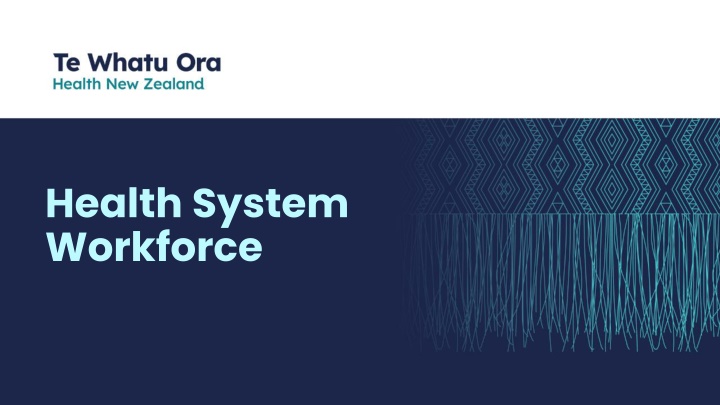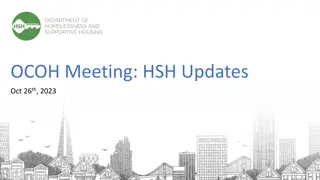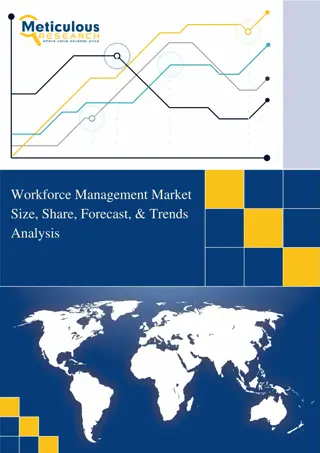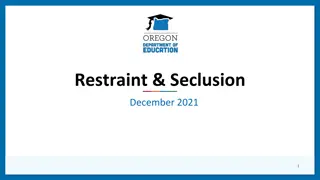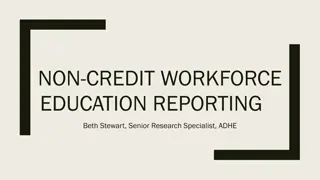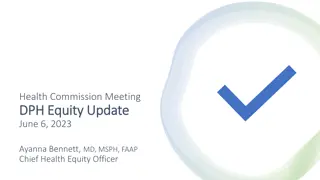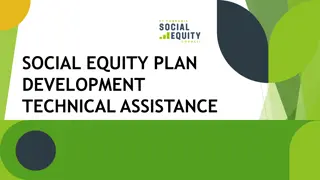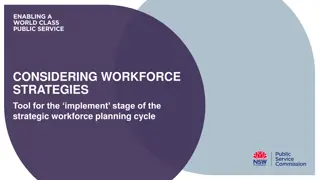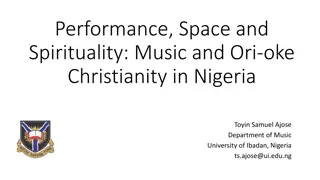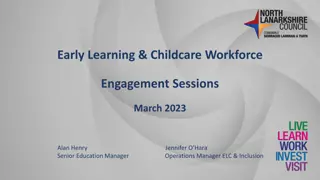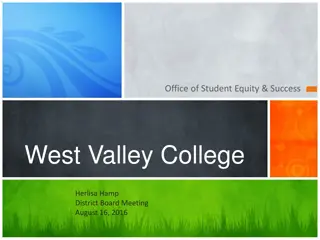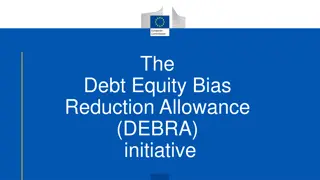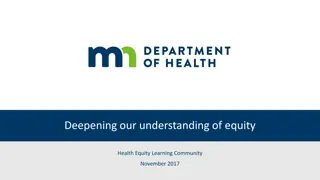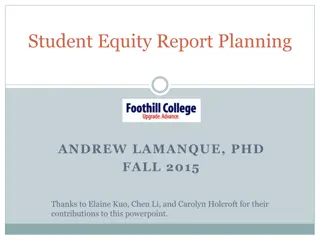Enhancing Health System Workforce for Māori Health Equity
Collaborative efforts between Te Aka Whai Ora, Te Whatu Ora, and Health New Zealand aim to address significant workforce pressures through a strategic workforce program. The approach focuses on equity, Te Tiriti partnership principles, and Māori self-determination. The overarching program principles emphasize Māori leadership, values, and workforce representation to achieve health equity.
Download Presentation

Please find below an Image/Link to download the presentation.
The content on the website is provided AS IS for your information and personal use only. It may not be sold, licensed, or shared on other websites without obtaining consent from the author.If you encounter any issues during the download, it is possible that the publisher has removed the file from their server.
You are allowed to download the files provided on this website for personal or commercial use, subject to the condition that they are used lawfully. All files are the property of their respective owners.
The content on the website is provided AS IS for your information and personal use only. It may not be sold, licensed, or shared on other websites without obtaining consent from the author.
E N D
Presentation Transcript
Health System Workforce
Background Collaborative, integrated and coherent approach to workforce Te Aka Whai Ora - M ori Health Authority Te Whatu Ora - Health New Zealand Manat Hauora Ministry of Health The workforce programme is whole of health system, integrated with the wider social care system A clear strategic intent with short and longer term initiatives to address significant workforce pressures Single workforce team in Te Whatu Ora and establishment of the Workforce Taskforce Joint leadership Ailsa Claire, Te Whatu Ora and Anna-Marie Ruhe, Te Aka Whai Ora Collaboration Pauline Sanders, Te Whatu Ora Pacific Health
Equity and Te Tiriti Model a M ori partnership approach Ensure equity and Te Tiriti are central to all Taskforce activities Ensure clear alignment between Taskforce activities and medium to long-term work planning by Te Whatu Ora and Te Aka Whai Ora What s good for M ori is good for everyone
Overarching Programme Principles Whakamaua: M ori Health Action Plan 2020-2025 and Te Tiriti o Waitangi principles Te Tiriti o Waitangi Are we actively enabling and advocating for M ori self-determination and mana motuhake in the design, delivery and monitoring of workforce activity and initiatives? Tino Rangatiratanga Equity Are we actively enabling and advocating for equitable access for M ori to workforce programmes and initiatives? principles Active Protection Are we demonstrating the dedicated effort required to achieve M ori Health equity through increasing M ori within the workforce? Options Are we actively enabling and advocating for Kaupapa M ori Services Workforce needs and hauora M ori models of understanding in our activities and initiatives? Partnerships Are we actively enabling and advocating for partnership with M ori with the governance, design, delivery and monitoring of Workforce activity and initiatives? Whakamaua: M ori Health Action Plan 2020-2025 and M ori Health & Disability Workforce Reflective question for leads, members and its workstreams to utilise: Will this (idea or decision) enable more M ori to participate in leadership and decision-making opportunities? Priority 2 (Whakamaua) Increase M ori decision-making throughout the Health and disability system s leadership and governance arrangements. Reflective question for leads, members and its workstreams to utilise: Will this (idea or decision) enable the reflection of the M ori population, M ori values and M ori models of practice within the profession? Priority 3 (Whakamaua) Develop a M ori Health and disability Workforce that reflects the M ori population, M ori values and M ori models of practice.
Workforce Strategy Led by Manat Hauora the Ministry of Health Strategic Framework Dec 2022 Health Workforce Strategy - 2023 Broad engagement Roadshows Webinars (3 agencies) Health workforce dialogue event On-line Engagement Tool Tatou https://tatou.health.govt.nz
SYSTEM STRATEGY He Korowai Oranga M ori Health Strategy 2014 Whakamaua Heath and Disability System Reform M ori Health Action Plan 2020-2025 WHAKAMAUA PRIORITY AREAS Cross sector cutting Quality and safety M ori crown relationships Insight and evidence M ori health and disability workforce M ori health sector development M ori leadership Performance and accountability TE AKA WHAI ORA FIVE YEAR SYSTEM PRIORITIES Ensuring all services are integrated and wh nau centred Ensuring M ori data requirements are met Developing a culturally safe workforce and strengthened M ori workforce Empowering M ori governance Ensuring primary care works for M ori Implementing evidence-based policy M ORI HEALTH WORKFORCE ACTION PLAN PRIORITY AREAS Leadership and development Whakatupu in health careers M tauranga M ori visibility and action Data and evidence M ori health workforce strategic plan Strengthening the use of health insights and intelligence Developing an inclusive leadership and culture A strong workforce wh nau Valuing the voices of consumers and wh nau TE PAE TATA (INTERIM HEALTH PLAN) PRINCIPLES The Health Charter
Our partnership approach A shared way of working which reflects a Te Ao M ori approach Kaupapa M ori / m taurangaM ori approaches ensure meaningful engagement with our wider partners and communities Informed by quality data and evidence Supports achievement of key priority areas for M ori health workforce development and growth Direct Co-commissioning Partnership commissioning Partnering with tertiary education providers and cross-government agencies and stakeholders Targeting M ori workforce development and growth across education and training programmes Increased investment in M ori specific education and training programmes Training and education provided across all levels of workforce, delivered regionally and nationally Focus on targeting M ori workforce development and growth Includes focus on key workforce priority areas Growing and scaling successful M ori models of education and training pathways Co-commissioned with Te Whatu Ora partners Commissioned directly by Te Aka Whai Ora Workforce Taskforce Working Groups
Pacific Health Workforce Team Vision Pacific Peoples: Te Whatu Ora: Pae Ora Healthy Futures Confident, thriving, resilient and prosperous Pacific Aotearoa Lalanga Fou Goals Thriving Pacific Languages, Cultures, and Identities Prosperous Pacific Communities DEVELOP Pacific Health Workforce Action Plan INFLUENCE Models of Care & Initiatives Confident, Thriving and Resilient Young People Resilient and Healthy Pacific Peoples Ola Manuia Pacific workforce are valued, supported and reflective of Pacific Aotearoa Levers for change INVEST Initiatives to Strengthen & Transform DELIVER Ola Manuia action in Te Pae Tata Trusted Strategic Relationships Pacific enabling Policies Integrated Pacific Models of Care Equitable Pacific workforce resourcing Accurate Pacific workforce data Equity for Pacific Pacific Health Priorities Pandemic Response Older People Children & youth Mothers & babies Long-term Mental health & well being People with disabilities conditions(cancer, gout, diabetes)
Pacific Health Workforce Timeline Workforce Planning Workforce Implementation Mar Dec Feb Mar 2023 Sep Oct 2022 Oct Nov 2022 Nov Dec 2022 Dec Jan 2023 2023 Appoint Interim Workforce Lead Appoint Interim Programme Manager Workforce Understand Structure Understand existing state Map workforce pipeline Consolidate programme of work Manage / review existing funding and contracts National workforce datasets & forecasting Sector engagement Draft National Workforce Action Plan Prioritisation of workforce actions Te Pae Tata, Ola Manuia alignment National Pacific Health Senate establishment Ongoing sector engagement Deliver agreed prioritised actions Monitor and evaluate Workforce Plan implementation Monitor and evaluate National Workforce Action Plan 9
Nature of Work RINGA | HANDS POKO| HEAD NG KAU | HEART Te Titiri is central to our mahi what works for M ori will likely work for everyone Cultural safety and addressing unconscious bias interwoven in every education and training experience Employees who live, work in and support their own communities are supported to develop and remain serving their communities Our work models deliver wellbeing, flexibility and satisfaction of employment Training is flexible, modular and includes micro-credentialling Health workers are confident to think and act beyond traditional care models Appropriate number of skilled workers to meet population needs and safe staffing Prior learning and life experience has assessment value The health outcomes communities and wh nau want are honored Our people are and feel well-led Learning methodology and core structures enable rapid creation of suitable workforce M ori aspirations and philosophies are valued Adaptable mindsets and careers are supported, developed and enabled Cultural worldviews are recognized and integrated into care Autonomy is as close to patients as possible Earn and learn is a valued and viable pathway for workforce training It s an honour to teach and placement is a mana-enhancing experience
Taskforce structure overview Planned Care Taskforce Chief Executives Te Whatu Ora & Te Aka Whai Ora Immunisation Taskforce Workforce Taskforce Chair Ailsa Claire (OBE) Co-chair Anna-Marie Ruhe Workforce Working Groups Administration & general management Allied Health, Technical & Scientific Nursing Medical Kai whina Midwifery Taskforce and working groups underpinned by the M ori Workforce and Pacific Workforce Action Plans.
MembersoftheTaskforce Ailsa Claire - Taskforce Chair/ Interim Workforce Lead, Te Whatu Ora Anna-Marie Ruhe - Taskforce Chair/Interim Workforce Commissioning Lead, Te Aka Whai Ora Abbe Anderson - National Commissioner, Te Whatu Ora Andrew Slater - National Director Innovation, Te Whatu Ora Dr Jason Tuhoe - General Practitioner Fiona Michel - Chief Executive Officer, Braemar Hospital Fionnagh Dougan - National Director, Hospital & Specialist Services, Te Whatu Ora Gillian Dudgeon - Deputy Chief Executive, Delivery, Tertiary Education Commission Kate Clapperton-Rees - New Zealand Council of Trade Unions (NZCTU) Mara Andrews - Deputy Chief Executive, Service Development and Relations, Te Aka Whai Ora Markerita (Meg) Poutasi - National Director, Pacific Health, Te Whatu Ora Mairi Lucas - New Zealand Council of Trade Unions (NZCTU) Professor Joanne Baxter - Dean, Dunedin School of Medicine, University of Otago Sonia Hawea - Chief Executive Officer, Taikura Trust Taima Campbell - Manukura Hauora - Te Puna Hauora Matua o Hauraki.
Kaiwhina Principles Whanau centred approach underpinned by cultural models of care Te Tiriti is embedded and upheld Model a partnership approach with key stakeholders Equity enabling Iwi and community led co-design Engagement, joined up and collaborative recognise and valuing potential, support and enable people to thrive and grow Continuous improvement model Vision Whanau and communities will achieve Pae Ora/Ola Manuia Through building and developing capability within whanau and communities Bygrowing, valuing and retaining the kai whina workforce Future State Plan to December 2022 Planned and strategic approach to developing Kai whina pathways Community knowledge increases and connectivity with the health system through the Kai whina role Flexible learning models that attract more people into these roles Earn and learn Multi-channel learning modalities Ability to train in rural areas More opportunities for disabled people | t ngata whaikaha to thrive in Kai whina roles The Kai whina role is recognised and valued People are proud to work in the Kai whina area Establish the Kai whina Workforce Working Group Service agreement in place with Toitu Te Wairoa to ensure prioritization of micro-credentialling Work programme agreed and implemented. Priority areas: Vaccinator health workforce development Micro-credentialling Oral health Health Care Assistants Earn as you learn model Sector engagement model developed Initial update to the sector
Further potential for Micro credentialling Roles to support registered professions working top of scope Pathways to registration Recognition of existing training programmes Flexible scopes of practice
Allied Health, Technical & Scientific Strategic challenges High workforce pressure (vacancies, fatigue, attrition) Difficult training pathway(s) with limitations for entry + high clinical placement training hours required Poor representation of Maori & Pacific people in the workforce Unable to work at top of scope due to stretched resource Workforce required for planned care restore & reset Changing models of care Additional FTE required to accommodate supervision for trainees currently not budgeted Out of scope: FTE, Remuneration & Reward Priority Areas Cardiac Sonographers Cardiac Physiologists Strategic Workforce pipeline audit Oral Health Therapists Anaesthetic Technicians Physiotherapists Occupational Therapists Psychologists Desired Outcomes & actions Te Tiriti partnership & Whakamaua priorities throughout NZ-based training programmes/sustainable programmes available Training programmes suitable for Maori & Pacific trainees Implementation of micro-credentialing Ability for AH S&T to work at top of scope to best support community Pharmacists Paramedics
Overview of initiatives International Recruitment Centre International recruitment campaign and ethical recruitment approaches Immigration support Registration fast track Real Nurses campaign Expanding the Nurse Practitioners programme NZREX bridging programme NZREX General Practice Pathway Internationally Qualified Nurses CAP Fund General Practice Education Programme Rural Locum Scheme GP and Public Health Doctors Return to Nursing Workforce Fund Return to Midwifery Workforce Fund Postgraduate Diploma for Pacific trained Nurses Radiology Registrar training placements
Working with TEC and Education providers Single point of connection/governance Understand the workforce pipeline Evaluation on training Common curriculum Modular training possibilities Micro-credentialling Training placements centrally coordinated
Future initiatives Earn-as-you-learn, scholarships, grants, apprenticeships, internships, financial support for M ori and Pacific students Entry-to-health jobs, schools, tertiary providers, life-long learning and development Flexible career pathways, micro-credentialling and modular training Cultural Safety Early in career development and support Review of regulatory framework and role of colleges (Ministry of Health) Whole system training settings Partnerships, including MSD, Corrections, ACC Prioritisation Framework
Working Together for Success
